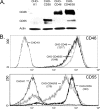Virion-associated complement regulator CD55 is more potent than CD46 in mediating resistance of mumps virus and vesicular stomatitis virus to neutralization
- PMID: 22761385
- PMCID: PMC3446622
- DOI: 10.1128/JVI.01154-12
Virion-associated complement regulator CD55 is more potent than CD46 in mediating resistance of mumps virus and vesicular stomatitis virus to neutralization
Abstract
Enveloped viruses can incorporate host cell membrane proteins during the budding process. Here we demonstrate that mumps virus (MuV) and vesicular stomatitis virus (VSV) assemble to include CD46 and CD55, two host cell regulators which inhibit propagation of complement pathways through distinct mechanisms. Using viruses which incorporated CD46 alone, CD55 alone, or both CD46 and CD55, we have tested the relative contribution of these regulators in resistance to complement-mediated neutralization. Virion-associated CD46 and CD55 were biologically active, with VSV showing higher levels of activity of both cofactors, which promoted factor I-mediated cleavage of C3b into iC3b as well as decay-accelerating factor (DAF) activity against the C3 convertase, than MuV. Time courses of in vitro neutralization with normal human serum (NHS) showed that both regulators could delay neutralization, but viruses containing CD46 alone were neutralized faster and more completely than viruses containing CD55 alone. A dominant inhibitory role for CD55 was most evident for VSV, where virus containing CD55 alone was not substantially different in neutralization kinetics from virus harboring both regulators. Electron microscopy showed that VSV neutralization proceeded through virion aggregation followed by lysis, with virion-associated CD55 providing a delay in both aggregation and lysis more substantial than that conferred by CD46. Our results demonstrate the functional significance of incorporation of host cell factors during virion envelope assembly. They also define pathways of virus complement-mediated neutralization and suggest the design of more effective viral vectors.
Figures










Similar articles
-
The paramyxoviruses simian virus 5 and mumps virus recruit host cell CD46 to evade complement-mediated neutralization.J Virol. 2009 Aug;83(15):7602-11. doi: 10.1128/JVI.00713-09. Epub 2009 May 20. J Virol. 2009. PMID: 19457998 Free PMC article.
-
Functional Dissection of the Dominant Role of CD55 in Protecting Vesicular Stomatitis Virus against Complement-Mediated Neutralization.Viruses. 2021 Feb 26;13(3):373. doi: 10.3390/v13030373. Viruses. 2021. PMID: 33652918 Free PMC article.
-
Parainfluenza virus 5 upregulates CD55 expression to produce virions with enhanced resistance to complement-mediated neutralization.Virology. 2016 Oct;497:305-313. doi: 10.1016/j.virol.2016.07.030. Epub 2016 Aug 6. Virology. 2016. PMID: 27505156 Free PMC article.
-
Inhibiting complement activation on cells at the step of C3 cleavage.Vaccine. 2008 Dec 30;26 Suppl 8(Suppl 8):I22-7. doi: 10.1016/j.vaccine.2008.11.001. Vaccine. 2008. PMID: 19388160 Free PMC article. Review.
-
Obstacles to cancer immunotherapy: expression of membrane complement regulatory proteins (mCRPs) in tumors.Mol Immunol. 2003 Sep;40(2-4):109-23. doi: 10.1016/s0161-5890(03)00112-3. Mol Immunol. 2003. PMID: 12914817 Review.
Cited by
-
Point mutations in the paramyxovirus F protein that enhance fusion activity shift the mechanism of complement-mediated virus neutralization.J Virol. 2013 Aug;87(16):9250-9. doi: 10.1128/JVI.01111-13. Epub 2013 Jun 19. J Virol. 2013. PMID: 23785199 Free PMC article.
-
Estimates of mumps seroprevalence may be influenced by antibody specificity and serologic method.Clin Vaccine Immunol. 2014 Mar;21(3):286-97. doi: 10.1128/CVI.00621-13. Epub 2013 Dec 26. Clin Vaccine Immunol. 2014. PMID: 24371258 Free PMC article.
-
Human adenovirus type 7 infection causes a more severe disease than type 3.BMC Infect Dis. 2019 Jan 9;19(1):36. doi: 10.1186/s12879-018-3651-2. BMC Infect Dis. 2019. PMID: 30626350 Free PMC article.
-
A Factor I-Like Activity Associated with Chikungunya Virus Contributes to Its Resistance to the Human Complement System.J Virol. 2020 Mar 17;94(7):e02062-19. doi: 10.1128/JVI.02062-19. Print 2020 Mar 17. J Virol. 2020. PMID: 31941783 Free PMC article.
-
CD59 association with infectious bronchitis virus particles protects against antibody-dependent complement-mediated lysis.J Gen Virol. 2017 Nov;98(11):2725-2730. doi: 10.1099/jgv.0.000962. Epub 2017 Oct 25. J Gen Virol. 2017. PMID: 29068273 Free PMC article.
References
-
- Atkinson JP, Liszewski MK, Richards A, Kavanagh D, Moulton EA. 2005. Hemolytic uremic syndrome: an example of insufficient complement regulation on self tissue. Ann. N. Y. Acad. Sci. 1056:144–152 - PubMed
-
- Beebe DP, Cooper NR. 1981. Neutralization of vesicular stomatitis virus (VSV) by human complement requires a natural IgM antibody present in human serum. J. Immunol. 126:1562–1568 - PubMed
Publication types
MeSH terms
Substances
Grants and funding
LinkOut - more resources
Full Text Sources
Miscellaneous

